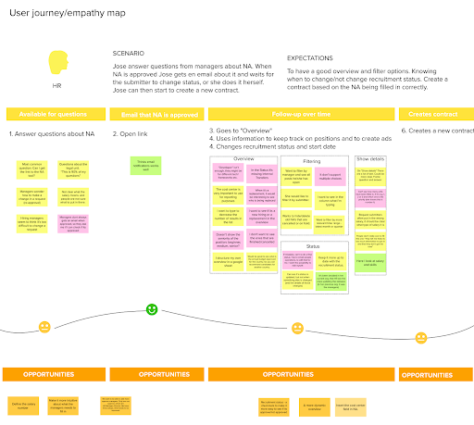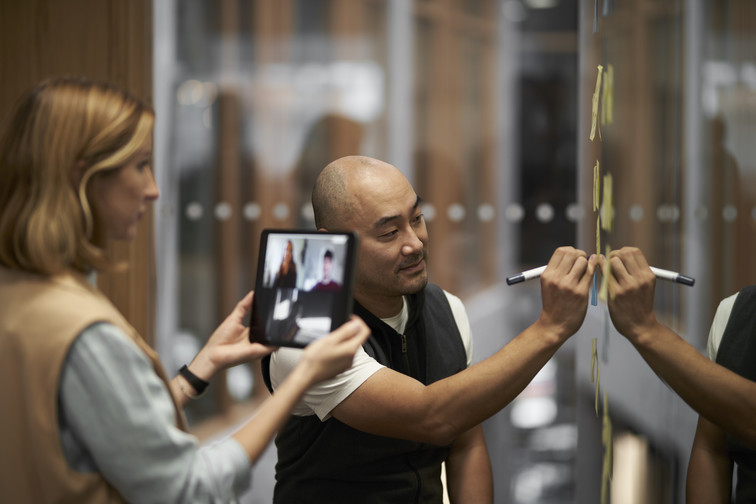I have been an intern at Visma as a part of the third year of my Bachelor studies in Interaction Design at Stockholms University. I have my background in account management, where I’ve always liked connecting with and understanding people.
In addition, I grew up in a musical family where creativity was always encouraged. So, as I was looking for an education, Interaction Design sounded like a good fit for me, which later on brought me to my internship here at Visma.
Interested in starting your career at Visma? Take a look at our Careers page.
Why I applied as a UX intern at Visma
What attracted me to apply for an internship at Visma was to learn about how UX is applied in an international software company. My internship lasted 9 weeks, during which I followed the Visma Value Loop and managed to do research for about 4 weeks, design and test for about 4 weeks.
I also prepared for handover and present my work for about 1 week—always with great support from my UX supervisor Amanda Lundius Mörck.

The Visma Value Loop
My project: Improving the Need Analysis tool
I was assigned a project called “Improving the Need Analysis tool”, on which I collaborated closely with Visma’s central People team (HR). In short, the Need Analysis tool is an approval flow tool used to initiate hiring processes.
The tool consists of two interfaces, the “Need Analysis form”, used by hiring managers and the “Need Analysis overview”, used by both hiring managers, approvers and HR. The goal of my project was to look at how we might improve it so it could offer a more efficient and user-friendly experience for its different users.
I started my project by getting an introduction from the People team so that I could map out the need analysis process and the different users. After that I conducted 14 interviews with the goal of understanding who the different users were and how they experienced using the tool as it is today.
Through these interviews, I mapped out user journeys and empathy maps, which gave me a clear indication of where in the process they experienced frustration and where we had the most opportunities to improve.
– Matilda
I also created a design brief with project objectives, key personas, key scenarios and key principles to have in mind when designing solutions.

User journey combined with empathy map (Mural board)
You might also be interested in reading: Visma UX Days 2020 – going remote with 100 designers.
In order to gather inspiration for design solutions, I facilitated a Design Studio with 7 experienced UX Designers. In just an hour, we generated many ideas and solutions together, which I could get inspired by when creating low fidelity prototypes.
I conducted 14 usability tests in order to enable a design that met the users different needs. I iterated the design based on my findings and created high fidelity prototypes which were later part of my handover to the People team.

Design studio (Mural board)
Some things that I discovered through my research was that:
- All users felt a need for a better overview, for example being able to see only ongoing requests, filter and sort on multiple choices and have a quick overview of how many requests they had.
- Hiring managers felt a need for better support and smartness in the need analysis form, for instance fetching data from other systems to get correct salary levels.
- Other important findings were that need analysis and other HR tools are hard to find since there’s a lot of content on Confluence (the internal documentation tool), and also that it’s difficult for new leaders to understand which tools are available and which tools should be used when.

The design suggestion for the Need Analysis form

The design suggestion for the Need Analysis overview (HR perspective)
Why you should do an internship
If you are a student, why should you do an internship at Visma? During my internship at Visma, working on this project, I’ve gotten the opportunity to take a lot of responsibility combined with great support when needed.
The optimal combination in order to grow as an interaction designer if you ask me! Also, to be able to put your learnings into practise with real products and real users that are in need of fine solutions, an internship is the way to go.
About the author

I’m Matilda, born and raised in the south of Dalarna, Sweden. I’m curious by nature, driven and eager to learn new things. What I find most interesting about UX is that it’s a highly varied practice that covers a lot of different aspects, including psychology, usability, design, branding and functionality. Always with something new to learn and grow from!

